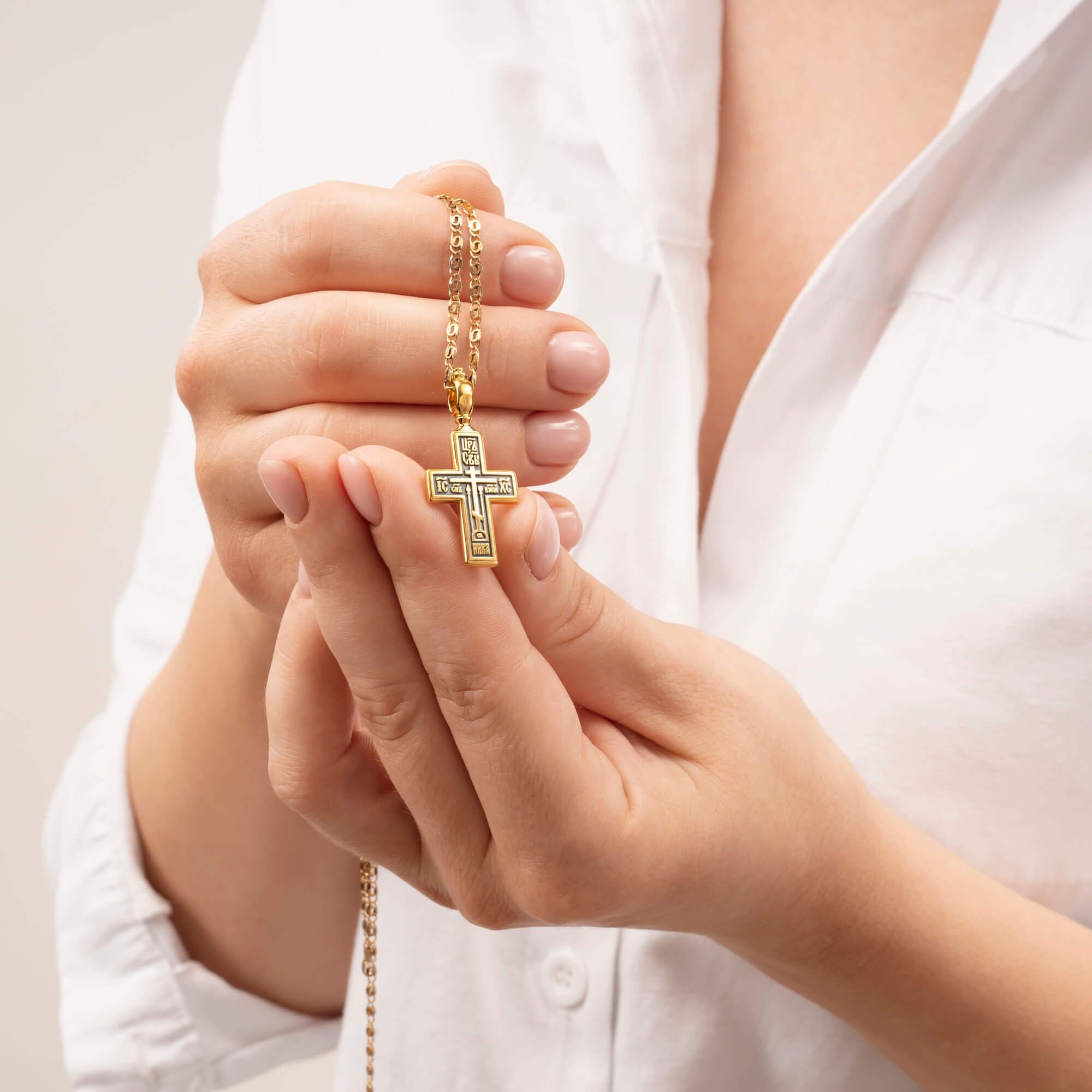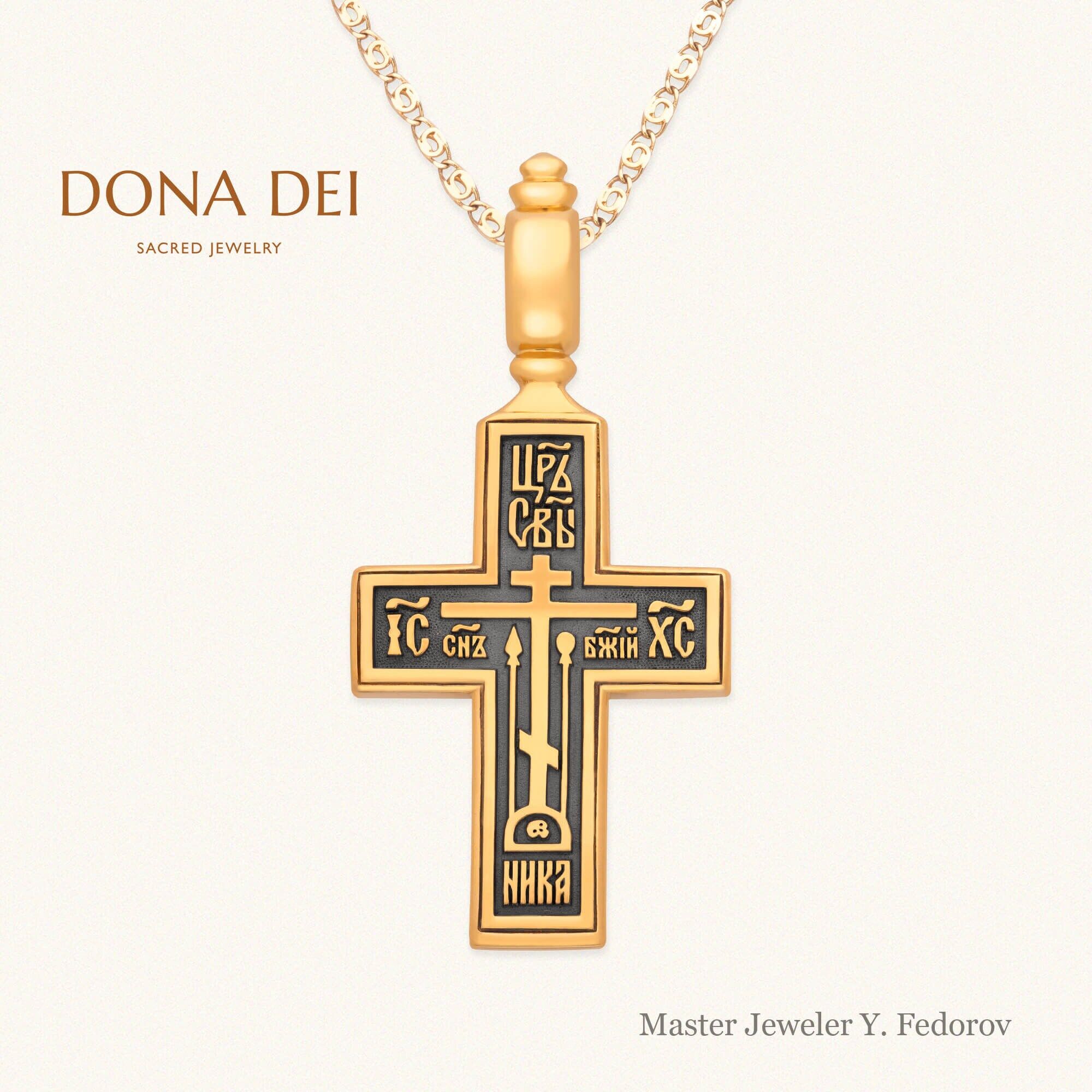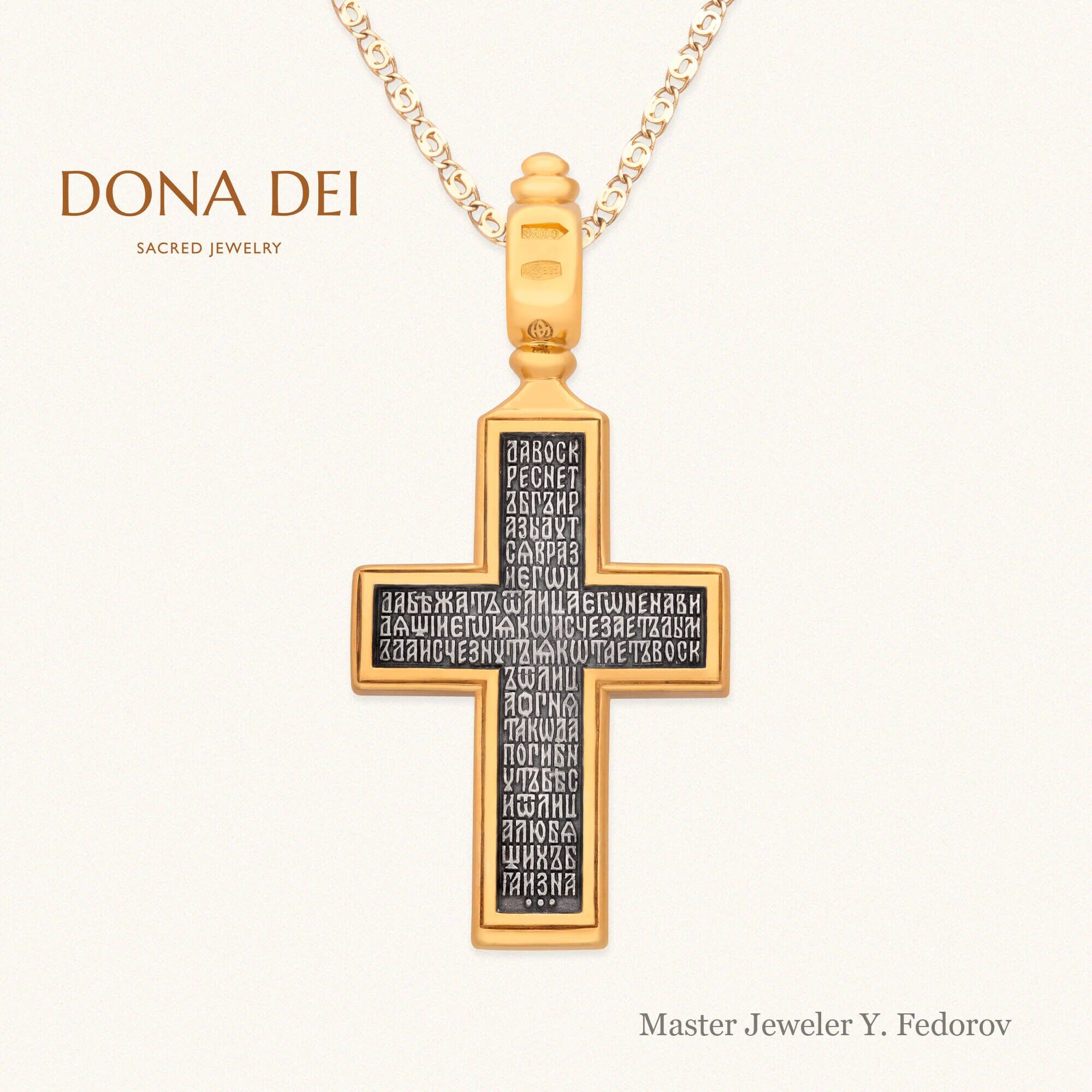Description
Size: 36.5 × 16.6 mm / 1.44 × 0.65 in
Weight: ~ 4.6 g / 0.16 ozOld Believers enameled cross pendant “Cross of Calvary. Prayer to the Holy Cross”
As the name suggests, this item is intended specifically for Old Believers and complies with prie-reform canonical requirements. However, the enameled cross pendant “Blossoming Cross” ...would be equally suitable for any Orthodox Christian. The schematic design makes it a perfect solution for those who prefer not to wear a more elaborate cross. The cross looks modest and simple, and can easily be matched with most outfits, whether formal or casual.
The symbolism of the Old Believers enameled cross pendant “Cross of Calvary. Prayer to the Holy Cross”
This cross pendant recreates a model that originated in Russia in the 17th century. The model has been in use ever since and remains widely popular among Old Believers. The cross has a simple four-pointed shape and straight rectangular bars, with the vertical bar being longer than the horizontal.
The central element of the frontal composition is a schematic replica of the Lord’s Precious and Life-Giving Cross. It is an eight-pointed Cross of Calvary set on Mount Golgotha. Inside the mountain, there is a skull that stands for the head of Adam. According to legend, Adam’s remains were buried in this exact location. In addition, the head of Adam highlights the connection between Adam and Christ. Christ was the One Who redeemed the original sin and revealed to humankind the path to eternal life. In doing so, he eliminated the consequences of Adam’s transgression. As a result, the Fathers of the Church refer to Christ as the New Adam. On either side of the Calvary Cross one can see the Instruments of the Passion, the spear and the cane with a sponge at the tip. They are subject to adoration along with the Cross and are invariably present on any wearable crosses used by Old Believers. Together with the eight-pointed cross and Mount Golgotha, they form a single unified composition. The actual figure of the Savior is conspicuously absent from this cross. This is due to the fact Old Believers’ conviction that the Savior cannot be portrayed on personal cross pendants. These pendants are meant for continuous wear and cannot be taken off under any circumstances. At the same time, the wearer may be forced to visit places where the presence of the Savior’s image is inappropriate. In some, it would be obscene or even tantamount to sacrilege.
The eight-pointed cross is particularly revered by the Old Believers. At the same time, it is a symbol of the Russian Orthodox Church as a whole. There is a long-standing tradition of depicting the eight-pointed cross as the instrument of execution used to crucify the Savior. It is seen as the best spiritual reflection of the genuine Cross of the Lord, the symbol of the Savior’s Sacrifice and Victory. The eight-point shape, in turn, consists of three parts. One is a basic four-pointed cross, the other two are additional horizontal bars at the top and bottom. The four-pointed cross serves as a graphic duplicate for the figure of the crucified Savior, the One “Who has created and maintains all things above and below, Who descended from up high and united the heavens with the earth, and then ascended from the earth into the heavens; He united all things within Himself and called upon every corner of the earth”.
The upper bar crowns the cross and denotes the true dignity of the Savior. This is confirmed by the inscription found nearby, which reads “King of Glory”. The inscription is an antonym to the ironic Pontius Pilate title and refers to the Lord’s glorious Ascension. The bottom bar stands for the foot of the cross. According to the Byzantine ceremonial regulations, the foot appears to have denoted the greatness of the person being portrayed. Its presence converts the cross into a throne and positions Christ as a king, the King of Glory. Moreover, the Cross is perceived as an altar, for which a foot is an essential attribute. Thus, the foot of the cross shows that the crucified Christ is not merely the one being sacrificed. He is also the High Priest offering Himself as the sacrifice. These meanings of the foot are confirmed in many books of Scripture (Is. 60:13; Ps. 98:5; Ps. 131:7; Mat. 22:44; Jews 10:12-13).
In keeping with the Russian tradition dating back to the 16th-17th centuries, the foot is depicted as a wide slanted board. The right-hand end is positioned somewhat higher than the left-hand one. At present, this version of the foot is canonical in Russian icon painting and has come to represent the “standard of righteousness”. The slanted or sloping foot reminds us of the two thieves who were crucified on either side of Christ. In addition, it represents the balance beam of the scales at the Last Judgment. One end is dragged down by the sins of the unrepentant thief, relegating him to hell. The other is freed by the repentance of the wise thief and soars upward, lifting him up to Heaven, as promised by the Savior. In a figurative way, this highlights the importance of repentance as the path to salvation. Furthermore, the reminder about the crucified thieves recreates a complete picture of the Crucifixion with three crosses.
This composition illustrates the regaining of the lost paradise with two trees in the middle. This is confirmed by the inscription, “МЛРБ”, or “Место Лобно Рай Бысть”, at the bottom. This is a traditional inscription translated as “the place of execution has become paradise”. Here, the Cross of Christ is a symbol of the Tree of Life. The thieves’ crosses, on the other hand, represent the duality of the tree of knowledge of good and evil. In combining the symbolism of the trees in Eden, the eight-pointed cross with the oblique foot could become the “Holy Tricomponent Tree” sung about in the Canon to the Precious and Life-Giving Cross (Song number 8).
In the remaining free space there are several other inscriptions that glorify the Lord. The edges of the horizontal bar contains the inscription I&С Х&С, an abbreviation for the name “Jesus Christ”. The name affirms that the Savior is, indeed, the Messiah, Whose coming was promised and foretold in the Old Testament. Inscribed along the horizontal bar is the Greek word НИКА (“the victor”), a reminder of Christ’s victory over hell and death.
The reverse contains the prayer to the Precious and Life-Giving Cross in the pre-reform spelling: “Let God arise and let His enemies be scattered; and let those who hate Him flee from His face. As smoke vanishes, let them vanish”. This prayer is traditionally attributed with a special protective meaning.
Technical details of the Old Believers enameled cross pendant “Cross of Calvary. Prayer to the Holy Cross”
The cross is made of grade-925 sterling silver and is decorated with hot enamel in different colors. The top part and the outer edges of the pendant are covered with 24kt gold plating. So are the Cross of Calvary at the front and the inscriptions. The small space with Adam’s head underneath the Cross of Calvary is blackened. At the top of the cross there is a fixed top part in a rounded, elongated shape.
The cross pendant is medium-sized, with dimensions of 1.44 × 0.65 in (36.5 × 16.6 mm), and light (0.16 oz / 4.6 g). This makes it quite convenient to wear, and, if necessary, to hide under one’s clothes.
About Master Jeweler Yuri Feodorov
Yuri Feodorov has spent over 35 years working with small sculptural items of an iconographic nature. He has created several collections of personal sacred items produced using a special casting technique, including cross pendants, scapulars and foldable icons. In addition, the artist has studied ancient Russian and Byzantine art and participated in archaeological expeditions and thematic exhibitions of Orthodox artwork.
Y. Feodorov’s collection is constantly exhibited at jewelry exhibitions and exhibitions of Orthodox items in Russia and abroad.
The artist’s work has received numerous awards, including several orders from the Carl Faberge Memorial Foundation. Y. Feodorov has repeatedly received incentives from the Russian Orthodox Church and the Ministry of Culture of the Russian Federation and won prizes at various exhibitions and contests.
It is important to mention that this item is made in Y. Feodorov’s workshops and together with the hallmark imprinted on the item it also has the passport of authenticity (shown in the picture).




